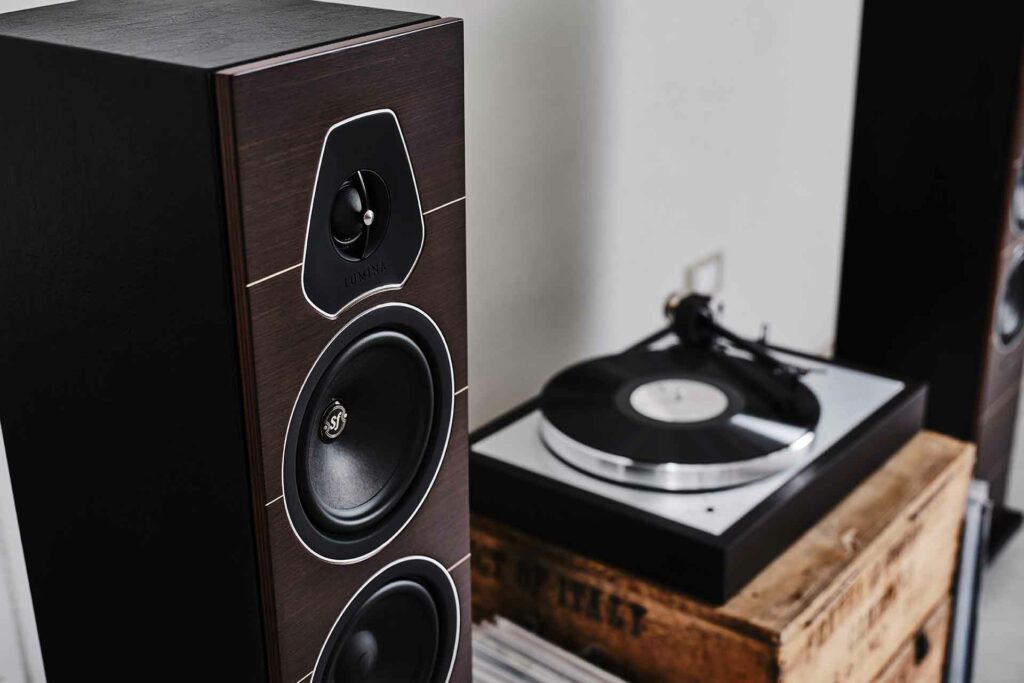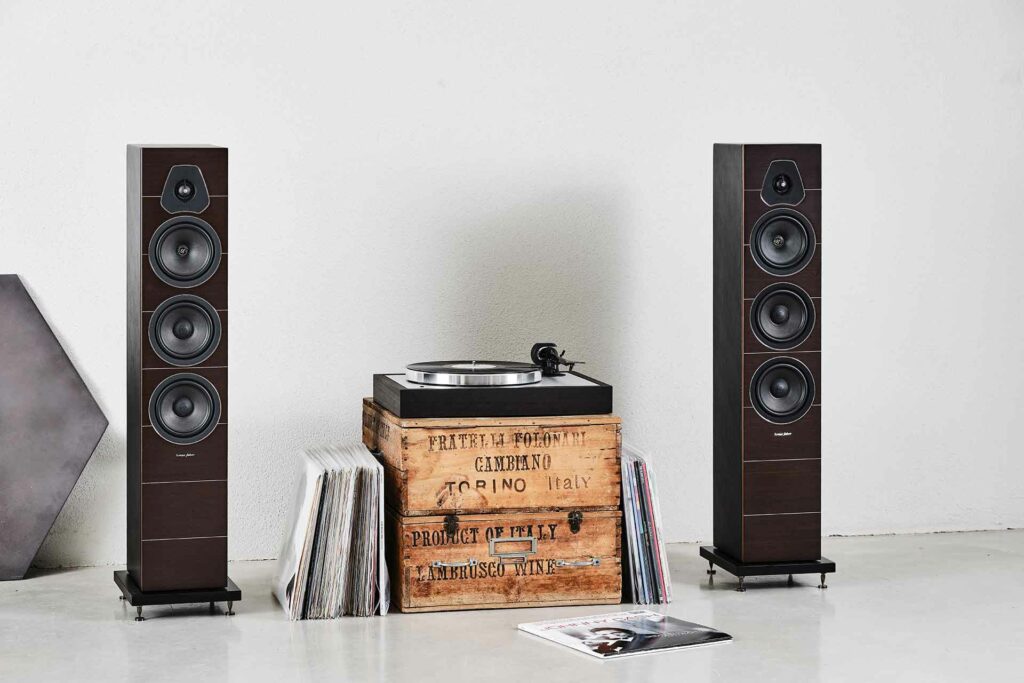Sonus faber has a longstanding heritage of making audiophile loudspeakers for music lovers. It all started in 1983 when fine Italian craftsmanship met fine music appreciation in Monteviale, Italy. Not much has changed since, except that we’ve had advances in material science, computer aided design, and four decades in which Sonus Faber has been refining their loudspeaker designs. Let’s explore why the Sonus faber Lumina V loudspeaker (buy at Crutchfield), which sits as the flagship of the company’s entry-level line, demonstrates why old-world ethics and a will to change with the times may yield a sophisticated, affordable, high-fidelity loudspeaker.

What Makes the Sonus faber Lumina V Loudspeakers So Special?
- Sonus faber was one of the first speaker manufacturers to explore and understand how cabinet shape and internal reflections in a loudspeaker affect the sound. Since then, they have refined their anti-resonant, lute-shape enclosures to eliminate cabinet coloration. The Lumina V looks like a fairly traditional loudspeaker; however, internally, the midrange and tweeter enclosures both have a lute-shaped secondary enclosure that provides the low-coloration, engaging voicing Sonus faber is known for.
- The Hybrid IFF Crossover – Paracross Topology Crossover is trickled down from the legendary Maxima Amator loudspeaker. The old-timey show “Mr. Ed” will tell you a horse is a horse. Many loudspeaker companies feel this way about the electronics that divide the sound to the drivers, called the crossover. Not much has changed since the dawn of electronics in terms of the basic analog filters used to divide the sound into bass and treble, and perhaps midrange frequencies as well. Yet, Sonus faber figured out a recipe for maximizing crossover performance that started in their $15,000 per pair offering, and has applied it to the $2,999 per pair Lumina V.
- Signature Italian craftsmanship is still ever-present in the Lumina V, which has an in-room presence akin to a piece of furniture, rather than a loudspeaker. The Lumina series may be the entry of the Sonus faber line; however, they are just as beautiful as the rest of the company’s offerings, and they are still handmade in Italy.
- Custom loudspeaker drivers, including a newly designed midrange and a trickled-down DAD (Damped Apex Dome) tweeter round off the attention to detail in the Lumina V. The Lumina V is truly a ground-up execution in loudspeaker design, and not just a cobbled together box of components that Sonus faber threw together to hit a price point.
- The Lumina V has the chops for both home theater use and serious music listening in moderately large spaces. It punches hard when it must, and can handle large power amps well.
Why Should You Care About the Sonus faber Lumina V?
The Sonus faber Lumina V are $2,999 per pair, which is not chump-change, but for many the Lumina V will be a long-standing feature piece in their home. With the outlandish pricing of loudspeakers today, it can feel like attaining high fidelity is an impossible task. It is not unreasonable to ask: “If the bests loudspeakers are the price of a Mid-western house and good loudspeakers are the price of a BMW 3 series automobile, then how can I get a great loudspeaker for a little less than one month’s salary at the national US average?”
Answering this question is straightforward. If having a dedicated, high-fidelity system is important in your lifestyle, great equipment that sacrifices very little of the musical experience does not have to be outrageously expensive. This is the pocket the Lumina V loudspeaker fits neatly into. The love of music is, and will continue to be, about the experience, not about the gear.

Some Things You Might Not Like About the Sonus faber Lumina V Floorstanding Audiophile Loudspeakers
- The Godawful five-way binding posts are a pain in the ass. This is certainly a nit-picky issue, but when originally unboxing the Sonus faber Lumina V speakers, it was shocking to see the high quality of their build. Small, heart-shaped bubbles were set afloat over my head and despite my skepticism that Sonus faber was about to sacrifice all they stood for to get in the affordable loudspeaker game, the finish and sound quality lived up to their earned reputation. As I gently slid two fingers along the seam between the leather wrapped sides and rear of the loudspeaker, I gasped. Why, out of all corners to cut, did Sonus faber use a cheap, prefabricated binding post plate? The thin metal binding posts mounted to plastic have wafer-like jumpers between the bi-wirable terminals, akin to something sold by the container-load from China. Like the licks to the center of a Tootsie Pop, the world may never know why this choice was made.
- The 6.5-inch woofers in the Lumina V dig deep enough in a sizeable room to not require a subwoofer, unless you are looking for the bottom octave (20 to 40 Hz) or they are being integrated into a home theater; however, they lack the overall ability to compress a room as a larger tower in their price-range would. This seems to be the largest trade-off for the sonic quality and balance the Lumina V offers.
- The Lumina V have the bass reflex vent on the bottom of the cabinet, which can be tricky in installation where the flooring is carpet. This is a good move in all sonic respects, but depending on the pile of the carpet where they may be used, they may need something larger than the supplied discs to prevent them from sinking into the carpet deep enough to block the port, which would negatively affect the sound. Four-inch by four-inch loose ceramic tiles below the feet made an easy two-dollar fix for my listening space.
Listening to the Sonus faber Lumina V Loudspeakers…
Having kids who love music is a wonderful gift in so many ways. One such way is the introduction to new pop music they grow with through the years. In 2014, the superstar Taylor Swift released “Shake It Off” from the album 1989. From the first beat reminiscent of Toni Basil’s “Mickey,” this compressed recording of bubble-gum-chewing aloofness is an absolute hoot to listen to.
No sonic detail was lost on the Lumina V. The separation and texture in Taylor’s voice was refined and complex, while the top-end of the cymbals had both the harmonics and body-tone they should possess. The beat was toe-tapping, and when the background vocals were present, their separation in the soundstage was fantastic. The Lumina V sounded invisible, which is a trait of Sonus faber loudspeakers and their signature, low-distortion midrange. “Shake It Off” was a very fun test and hard evidence that the Lumina V are a high-fidelity loudspeaker. Sonus faber is coming out of the gate swinging their hardest with these loudspeakers that perform not only with complex, natural instruments, but across the musical board.
After swinging through Taylor Swift’s neighborhood, some more serious music for evaluating the Lumina V audiophile loudspeakers is in order. In January 2020, the famous film score composer John Williams (87 years young) returned to conduct some of his famous works with the Wiener Philharmonic Orchestra. John Williams in Vienna has one of the best recordings of “Main Title (From “Star Wars: A New Hope”) I have come across on Qobuz. It is a 24-bit recording that preserves the incredible dynamic range of the Wiener Philharmonic.
From the first orchestra hit, the Lumina V loudspeakers separates out the complexity of the orchestra well. The critical midrange features of the strings and brass are full of texture and low-distortion life. The bells and cymbals are extended and float in a large, well-balanced soundstage that is beyond the boundaries of the loudspeakers in every direction. The timbre toed the line between warm and the warm side of neutral. These traits also preserved the space the orchestra was recorded in, and it provided the feeling of being present at the performance. The dynamics were acceptable, but I did wish there was a little more oomph that a larger loudspeaker typically affords. Not necessarily in overall volume, because the Lumina V had no problem filling the room, but in overall musical presence. Do The Sonus faber Lumina V Have Good Resale Value?
Do the Sonus faber Lumia V Speakers Have Good Resale Value?
Yes they do. Sonus faber speakers are sold in mainstream audio stores all across North America and in conjunction with their now brothers-in-brand for electronics, McIntosh and Pro-ject. These speakers aren’t so crazy expensive (like other Sonus faber offerings) that they won’t be appealing a few years down the road to that guy on Audiogon.com, eBay.com, and elsewhere. This is a pretty safe audiophile investment in terms of floorstanding speakers.
Who Is the Competition for the Sonus faber Lumina V Loudspeakers?
- Tekton Design Double Impact ($3,400 per pair): Remember we were talking about presence? This is it. The Double Impact features a dual 10-inch woofer, dual six-inch midrange, and an insane seven-tweeter array in a 4-way loudspeaker whose design is patented. Tekton loudspeakers are an amazing experience to listen to. They give you all the impact and presence of an ultra-high-end loudspeaker such as the Focal Utopia or Wilson ALEXX but at a much more affordable price point. There is no free lunch in this world, though, and Tekton loudspeakers are not as slick in terms of industrial design.
- Polk Audio L600 ($2.998 per pair – buy at Crutchfield) It is impossible to leave out this recent offering from Polk Audio. The Polk Audio L600 is packed full of technology in its three-way design, with dual seven-inch woofers, and is a reminder of Polk’s 45 years of progress. They look great, and solve that pesky downward firing port problem. The L600 has an accommodation on the top panel to add an Atmos speaker module for home theater applications.
- Dynaudio Evoke 30 (3,499 per pair) Dynaudio has been making revered loudspeaker drivers for nearly 50 years. The Evoke 30 is their entry-level tower offering, and incorporates their top-tier technology. The Evoke 30 retail for $3,499 per pair, but catch them on sale and they can be significantly less. The keyword to Dynaudio loudspeaker is refinement. They will ultimately offer a more musically precise experience than the more romantic sound of the Lumina V audiophile loudspeakers.
Final Thoughts on the Sonus faber Lumina V Loudspeakers
The Sonus faber Lumina V represents the flagship of Sonus faber’s entry-level loudspeaker line. While entry-level, it certainly carries a much more musically sophisticated sound that is a hallmark of Sonus faber. The combination of their acceptably full-range frequency response, furniture-grade looks, small footprint, and technology trickled down from their much higher end siblings, makes the Lumina V a great value at $2,999 pair. The Sonus faber Lumina V loudspeaker isa highly recommended transducer for anyone on a tight budget who wants to buy once, cry once, and have great music for years to come.




Why are there Lumina III’s in all the photos ? Are you sure you really tested the Lumina V ? 😉
I am not sure that you are correct. Maybe you are but these were the images that were sent from McIntosh Group. Granted that was two PR people ago (they have had a lot of turnover)
I can assure you that the speaker is correct in that Michael OWNS THEM and they are at his house now.
In other news, I JUST boxed up and shipped back some Sonetto Vs last week. That review (from me) will go live later in the year. Stay tuned!
Jerry